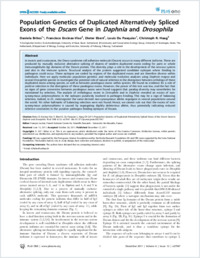Population genetics of duplicated alternatively spliced exons of the Dscam gene in Daphnia and Drosophila
- Brites, Daniela Zoologisches Institut, Evolutionsbiologie, University of Basel, Switzerland
- Encinas-Viso, Francisco Community and Conservation Ecology Group, University of Groningen, Haren, The Netherlands
- Ebert, Dieter Zoologisches Institut, Evolutionsbiologie, University of Basel, Switzerland
- Pasquier, Louis Du Zoologisches Institut, Evolutionsbiologie, University of Basel, Switzerland
- Haag, Christoph R. Department of Biology, Ecology and Evolution, University of Fribourg, Switzerland
-
12.01.2011
Published in:
- PLoS ONE. - 2011, vol. 6, no. 12, p. e27947
English
In insects and crustaceans, the Down syndrome cell adhesion molecule (Dscam) occurs in many different isoforms. These are produced by mutually exclusive alternative splicing of dozens of tandem duplicated exons coding for parts or whole immunoglobulin (Ig) domains of the Dscam protein. This diversity plays a role in the development of the nervous system and also in the immune system. Structural analysis of the protein suggested candidate epitopes where binding to pathogens could occur. These epitopes are coded by regions of the duplicated exons and are therefore diverse within individuals. Here we apply molecular population genetics and molecular evolution analyses using Daphnia magna and several Drosophila species to investigate the potential role of natural selection in the divergence between orthologs of these duplicated exons among species, as well as between paralogous exons within species. We found no evidence for a role of positive selection in the divergence of these paralogous exons. However, the power of this test was low, and the fact that no signs of gene conversion between paralogous exons were found suggests that paralog diversity may nonetheless be maintained by selection. The analysis of orthologous exons in Drosophila and in Daphnia revealed an excess of non-synonymous polymorphisms in the epitopes putatively involved in pathogen binding. This may be a sign of balancing selection. Indeed, in Dr. melanogaster the same derived non-synonymous alleles segregate in several populations around the world. Yet other hallmarks of balancing selection were not found. Hence, we cannot rule out that the excess of non-synonymous polymorphisms is caused by segregating slightly deleterious alleles, thus potentially indicating reduced selective constraints in the putative pathogen binding epitopes of Dscam.
- Faculty
- Faculté des sciences et de médecine
- Department
- Département de Biologie
- Language
-
- English
- Classification
- Biological sciences
- License
-
License undefined
- Identifiers
-
- RERO DOC 28356
- DOI 10.1371/journal.pone.0027947
- Persistent URL
- https://folia.unifr.ch/unifr/documents/302276
Statistics
Document views: 100
File downloads:
- pdf: 134
